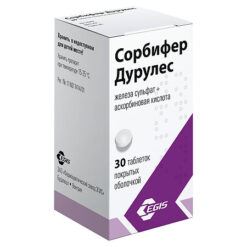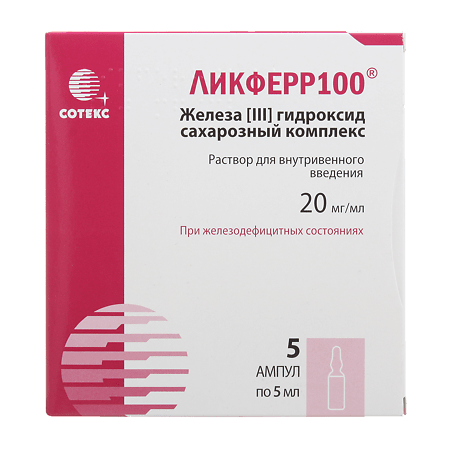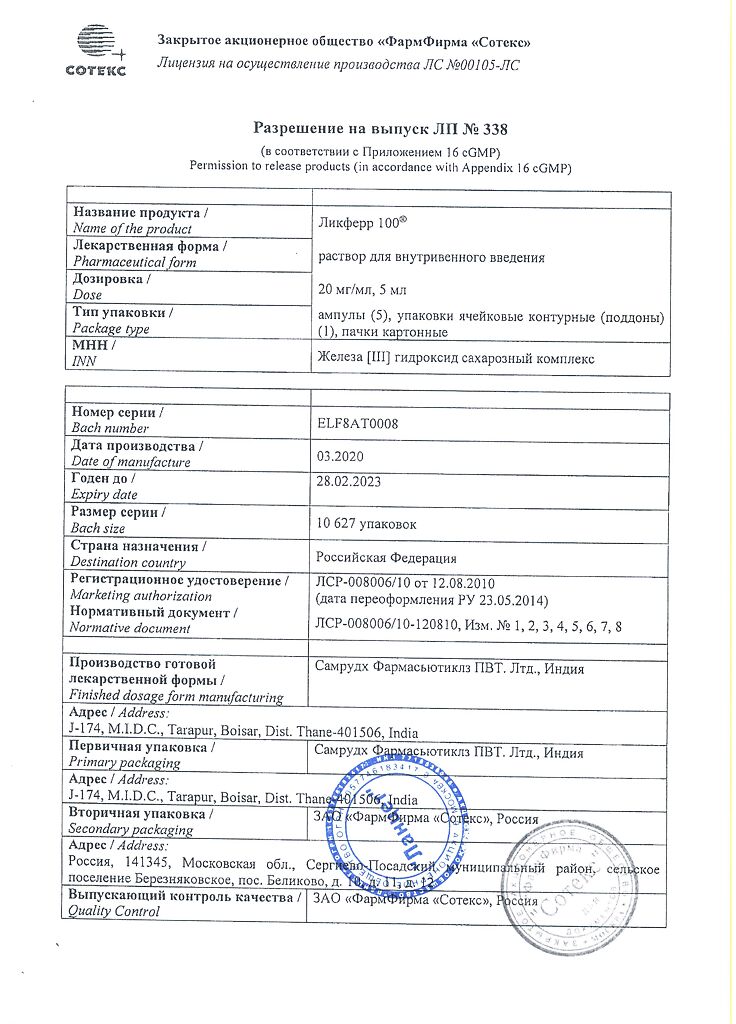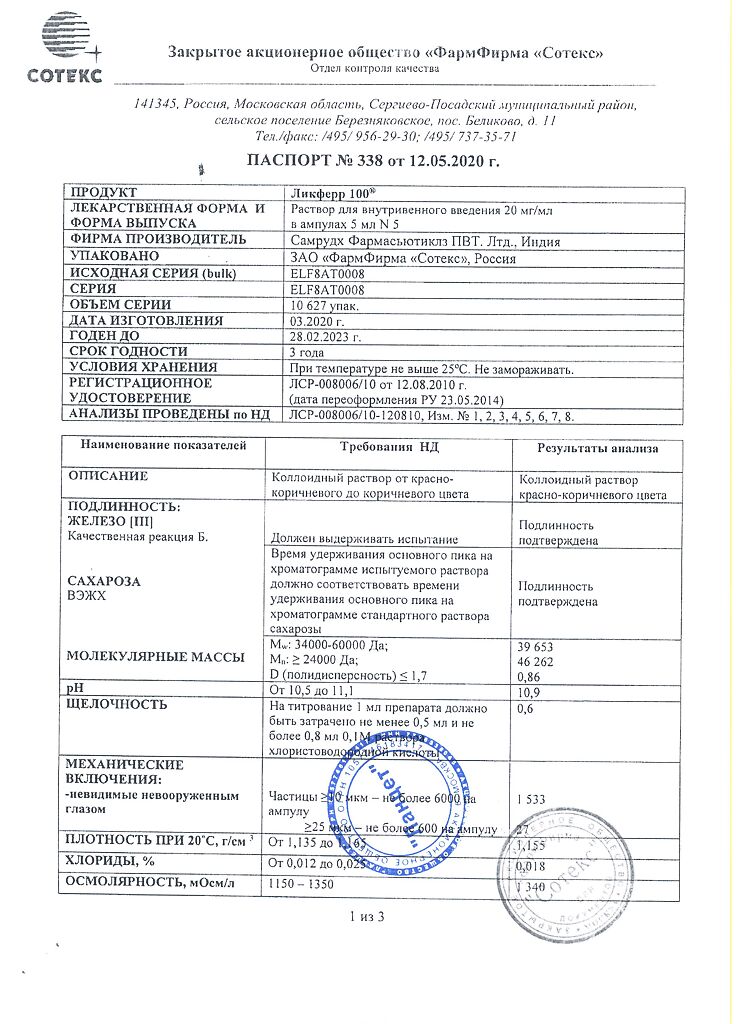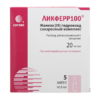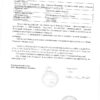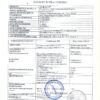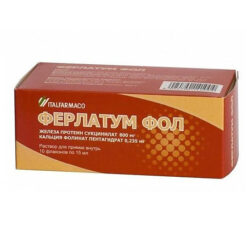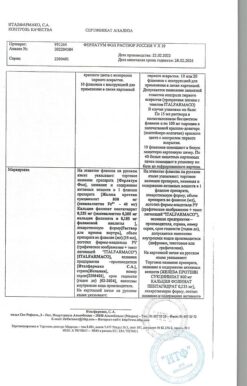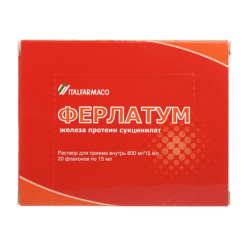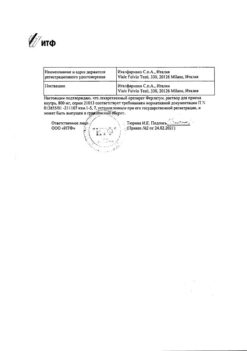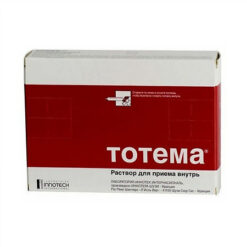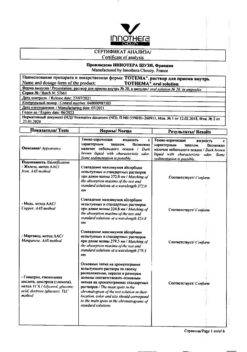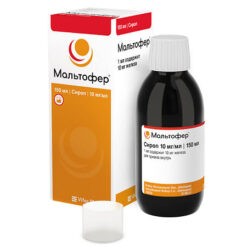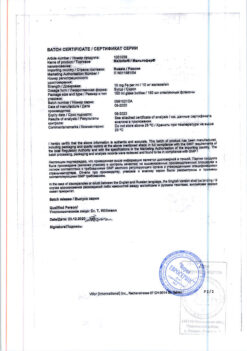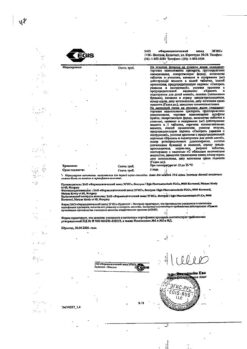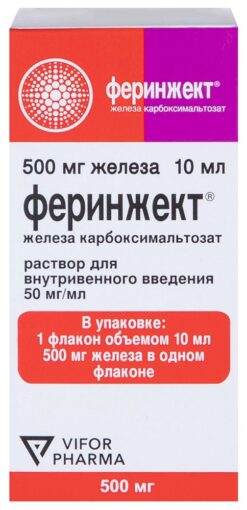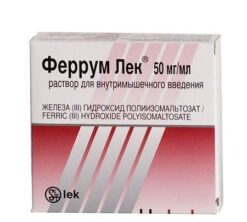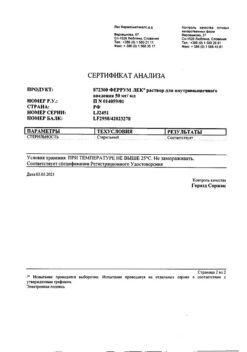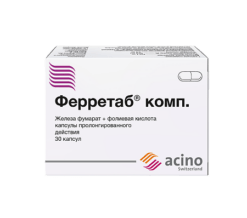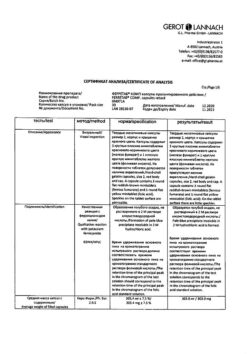Subtotal: €11.51
Lycferr100,20 mg/ml 5 ml 5 pcs
€51.85 €43.21
Liqueferr100 is an anti-anemic.
Pharmacodynamics
The preparation of iron, regulates metabolic processes. It is a colloidal solution, which consists of spheroidal iron-carbohydrate nanoparticles. The core (center) of each particle contains iron (III) hydroxide. The core is surrounded by a sucrose shell, which stabilizes the iron (III) hydroxide, slowly releases the bioactive iron and keeps the resulting particles in colloidal solution. As a result, a complex is formed with a molecular weight of approximately 43 kDa, so that it cannot be excreted unchanged through the kidneys. Iron (III) in this complex is bound to structures similar to those of natural ferritin.
The active substance of the preparation – iron (III) hydroxide sucrose complex – dissociates into iron and sucrose in the reticuloendothelial system when entering the body. Due to the lower stability of iron sucrose compared to transferrin, there is a competitive exchange of iron in favor of transferrin. As a result, about 31 mg of iron is transferred in 24 h. Polycyclic iron (III) hydroxide is partially conserved as ferritin after complexation with the protein ligand, hepatic mitochondrial apoferritin. The hemoglobin index increases faster and with greater reliability than after therapy with iron (II)-containing drugs. Administration of 100 mg of iron (III) leads to an increase in hemoglobin by 2-3%; during pregnancy, 2%. The toxicity of the drug is very low. The therapeutic index is 30 (200/7).
Pharmacokinetics
After a single IV administration of Liquiferr100® containing 100 mg of iron, the Cmax of iron (average – 538 μmol) is reached 10 min after injection. T1/2 is 6 h. Vss is approximately 8 liters, indicating a low distribution of iron in the body fluids.
The renal excretion of iron for the first 4 h after injection is less than 5% of total clearance. After 24 h, serum iron content returns to the original (pre-injection) value and approximately 75% of sucrose leaves the vascular stream.
Indications
Iron deficiency conditions (including iron deficiency and acute posthemorrhagic anemia) in patients with the following conditions:
the need for rapid iron replenishment;
intolerance to oral iron supplements;
the presence of gastrointestinal diseases that make it impossible to take oral iron supplements.
Pharmacological effect
Likferr100 – antianemic.
Pharmacodynamics
Iron supplement regulates metabolic processes. It is a colloidal solution that consists of spheroidal iron-carbohydrate nanoparticles. At the core (center) of each particle is iron (III) hydroxide. The core is surrounded by a shell of sucrose, which stabilizes iron (III) hydroxide, slowly releases bioactive iron and maintains the resulting particles in a colloidal solution. As a result, a complex is formed, the molecular weight of which is approximately 43 kDa, as a result of which its excretion through the kidneys in unchanged form is impossible. The iron(III) in this complex is associated with structures similar to natural ferritin.
The active substance of the drug – iron (III) hydroxide sucrose complex – when it enters the body, it dissociates in the reticuloendothelial system into iron and sucrose. Due to the lower stability of iron saccharate compared to transferrin, competitive iron metabolism is observed in favor of transferrin. As a result, about 31 mg of iron is transferred in 24 hours. Polycyclic iron (III) hydroxide is partially preserved in the form of ferritin after complexation with the protein ligand – apoferritin of liver mitochondria. The hemoglobin level increases faster and with greater reliability than after therapy with drugs containing iron (II). Administration of 100 mg of iron (III) leads to an increase in hemoglobin by 2–3%; during pregnancy – by 2%. The toxicity of the drug is very low. The therapeutic index is 30 (200/7).
Pharmacokinetics
After a single intravenous injection of Likferr100® containing 100 mg of iron, Cmax of iron (on average 538 µmol) is achieved 10 minutes after injection. T1/2 – 6 hours. Vss is approximately 8 l, which indicates a low distribution of iron in body fluids.
Iron excretion by the kidneys during the first 4 hours after injection is less than 5% of the total clearance. After 24 hours, the serum iron content returns to its original (pre-administration) value, and approximately 75% of sucrose leaves the vascular bed.
Special instructions
The rate of administration of the drug Likferr100® should be strictly observed (with rapid administration of the drug, blood pressure may decrease). Higher incidence of undesirable side reactions (especially decreased blood pressure), incl. and severe, is associated with an increase in dose. Thus, the timing of drug administration given in the section “Dosage and Administration” must be strictly observed, even if the patient does not receive the drug at the maximum tolerated single dose.
During the period of administration of the drug Likferr100®, it is necessary to monitor hemodynamic parameters.
Likferr100® should be prescribed only to those patients in whom the diagnosis of anemia is confirmed by appropriate laboratory data (for example, the results of determining serum ferritin or hemoglobin and hematocrit, the number of red blood cells and their parameters – the average volume of a red blood cell or the average hemoglobin content in a red blood cell).
IV iron supplements may cause allergic or anaphylactoid reactions, which can be potentially life-threatening. Patients with bronchial asthma, eczema, atopic diseases, polyvalent allergies, allergic reactions to other iron preparations, as well as patients with low serum iron-binding capacity and/or folic acid deficiency, have an increased risk of developing allergic or anaphylactoid reactions (see “Contraindications”, With caution).
Studies conducted in patients with hypersensitivity reactions to iron dextran showed the absence of complications during treatment with the drug.
Penetration of the drug into the perivenous space should be avoided, because If Likferr100® gets outside the vessel, it leads to tissue necrosis and brown discoloration of the skin. If this complication develops, it is recommended (if the needle is still in the vessel) to inject a small amount of 0.9% sodium chloride solution. To speed up the removal of iron and prevent its further penetration into surrounding tissues, it is recommended to apply heparin-containing drugs to the injection site (apply the gel or ointment with light movements, without rubbing).
Administration of the drug in the presence of sediment is unacceptable.
1 ml of Likferr100® contains from 260 to 340 mg of sucrose. These data must be taken into account in patients with diabetes. When administering the drug by drip, depending on the indications, the maximum tolerated single dose can reach 500 mg of iron, which corresponds to the administration of 8.5 g of sucrose. When recalculating this amount of carbohydrates into XE (1 XE = 12 g of carbohydrates), it corresponds to 0.7 XE.
During therapy with erythropoiesis stimulants, iron metabolism is monitored using indicators such as serum ferritin concentration and transferrin iron saturation (TIS). Determining the number of hypochromic erythrocytes and the hemoglobin concentration in reticulocytes helps to decide on the need to prescribe IV iron supplements when there is hyperferritinemia and low IF. The risk of iron overload is offset by blood loss during dialysis-related procedures (1–3 g of iron lost per year). Serum ferritin concentrations should be monitored regularly. Serum ferritin concentrations above 500 μg/L (with normal C-reactive protein levels) that persist for a long time may indicate iatrogenic iron overload. In such cases, iron supplements should be discontinued (therapy with erythropoiesis stimulants should be continued). Due to the fact that iron stimulates the growth of most microorganisms, iron supplements should be discontinued if acute bacterial infections develop. Also, IV iron therapy should be used with caution in patients with permanent dialysis catheters.
Impact on the ability to drive vehicles or operate potentially dangerous machinery. It is recommended to exercise caution when driving or operating potentially dangerous machinery.
Active ingredient
Iron III hydroxide sucrose complex
Composition
Active ingredient:
iron (III) hydroxide sucrose complex (in terms of iron (III) 20 mg;
Excipients:
sodium hydroxide – up to pH 11;
water for injection – up to 1 ml
Pregnancy
The drug is contraindicated in the first trimester of pregnancy. In the second and third trimesters of pregnancy, it is used only if the expected benefit to the mother outweighs the potential risk to the fetus.
During lactation, the safety of the drug has not been established. It is recommended to stop breastfeeding (if necessary, use the drug) or discontinue the drug.
Contraindications
hypersensitivity to the components of the drug Likferr100®;
anemia not associated with iron deficiency;
presence of signs of iron overload (hemosiderosis, hemochromatosis) or disruption of the process of its utilization;
I trimester of pregnancy (see “Use during pregnancy and lactation”).
With caution: bronchial asthma; eczema; polyvalent allergy; allergic reactions to other parenteral iron preparations (due to the high risk of allergic reactions – see “Special Instructions”); liver failure; acute infectious diseases; low serum iron-binding capacity and/or folic acid deficiency; diabetes mellitus (see “Special Instructions”); age under 18 years (due to insufficient data on safety and effectiveness).
Side Effects
From the central nervous system: dizziness, headache, loss of consciousness, paresthesia.
From the cardiovascular system: palpitations, tachycardia, decreased blood pressure, collapsed states, feeling of heat, flushing of the face, peripheral edema.
From the respiratory system: bronchospasm, shortness of breath.
From the digestive system: transient taste disturbances (especially a metallic taste in the mouth), diffuse abdominal pain, pain in the epigastric region, diarrhea, taste perversion, nausea, vomiting.
From the skin: erythema, itching, rash, pigmentation disorders, increased sweating.
From the musculoskeletal system: arthralgia, back pain, joint swelling, myalgia, pain in the extremities.
Allergic reactions: anaphylactoid reactions, facial swelling, laryngeal swelling.
Other: asthenia, pain in the chest, back, feeling of heaviness in the chest, weakness, feeling of malaise, pallor, increased body temperature, chills.
Local reactions: pain and swelling at the injection site (especially if the drug gets extravasally), phlebitis, burning sensation, hematoma.
Interaction
The simultaneous administration of the drug Likferr100® with dosage forms of iron for oral administration is unacceptable, because absorption of iron from the gastrointestinal tract decreases. Treatment with oral iron supplements can begin no earlier than 5 days after the last injection.
Likferr100® can be mixed in one syringe only with 0.9% sodium chloride solution. No other IV solutions or therapeutic agents are allowed to be added due to the risk of precipitation and/or other pharmaceutical interactions. Compatibility with containers made of materials other than glass, PE and PVC has not been studied.
If the patient is taking other medications, it is necessary to consult a doctor.
Overdose
Symptoms: decreased blood pressure (signs of collapse appear within 30 minutes), symptoms of hemosiderosis.
Treatment: symptomatic, if necessary – drugs that bind iron (chelators), for example deferoxamine.
Storage conditions
At a temperature not exceeding 25 °C (do not freeze)
Shelf life
3 years
Manufacturer
PharmFirma Sotex, Russia
| Shelf life | 3 years |
|---|---|
| Conditions of storage | At a temperature not exceeding 25 °C (do not freeze) |
| Manufacturer | PharmFirm Sotex, Russia |
| Medication form | solution |
| Brand | PharmFirm Sotex |
Related products
Buy Lycferr100,20 mg/ml 5 ml 5 pcs with delivery to USA, UK, Europe and over 120 other countries.

